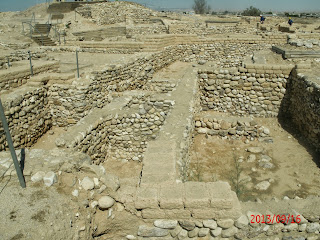I am so sorry this is way over due but better late than never! I thought I better describe what the Negev is and what our field trip consisted of. The Negev is a desert area south of Israel. The term comes from Hebrews word for "dry" but is used in the Old Testament to denote the direction south. Cool Fact: the Ark of the Covenant was made of wood from the acacia tree ("shittim" in Exodus 25:10) which is grown in this arid region. If you see any trees in the background most likely they are these same kind of trees. Here are some pictures with a short description to follow!
The Negev Desert-Bedwin community
Our first stop was at a Bedwin town where we stopped at the Lakiya Negev Weaving store and organization. This is an all women organization who raise money for the Bedwin community by making there own wool/yarn and creating rugs, pillow, key chains, belts, and everything you can imagine! They do it all out of a little building with a canopy in the back (pictured below). They were so welcoming to invite us into their shop and canopy, give us a drink, and share information about their organization. Their mission is to raise money for the Bedwin town as well as educate and provide job opportunities to those who are able. I had never thought how hard it would be to sheer the sheep, clean the "fur", comb it out, dye it, and then try to make something! These women are amazing! It reminded me of my mom's mad skills :)
This is my attempt to gather the wool into something useful. (which is very hard!!)
TEL ARAD!!
THis ancient cit ylies in the eastern Negev and consists of ruins of a Canaanite city from the Early Bronze Age and also an Israelite fortress. Arad is mentioned in the BIble as one of the cities whose inhabitants prevented the Israelites from entering into the Promised Land. Some of the scriptures we read and that Arad is mentioned in include: Numbers 21:1, Joshua 12:14, Numbers 12: 25-32, and Numbers 14:20-25. We also talked about sometimes its hard to see things that are right in front of you because you don't believe. In Alma 5 it talks about how we must see with the eye of belief in order to think and do. Just to kinda describe the City and what we saw (since I don't have very many pictures at this time, my camera died and I've haven't received the pictures from my friend).
The early Canaanite city was divided into quaters which housed a palace, temples, markets, and residential living quarters. There are no natural springs in the area, therefore the they were forced to capture surface rainwater, which flowed down the streets and drained into a pool located in the middle of the city.
*The most important find inside the upper fortress was a small temple complex from the Israelite period that patterned after the temple in Jerusalem. The temple consisted of an outer courtyard with a sacrificial alter, a second courtyard, and the HOly of HOlies. There were rooms located near the courtyard of the temple which may have housed ritual vessels used by the priests. The alter was built of unhewn stone and featured a runoff channel for the blood of the animal sacrifices. The temple was probably in use until either the time of Hezekiah or Josiah.
Notice in this picture you have to take an immediate right to get into the city/temple wall. This is a strategy for protection because those who are attempting to attach can't charge directly but have to turn and slow down. Also it is harder for RIght handed men to attack because of this feature. (Fun Fact: Benjamin warriors were left handed and were probably trained this way for fighting/attacking)
Beersheba (Beersheva)
Tel Beersheva is located between the wadis Hebron and Beersheba. (A wadi is a dry riverbed, a tel is a hill). It is a few miles east of the modern city of Beersheba. Beersheba in Hebrew means well of seven, or because sheva also means oath, it could mean well of the oath (Gen 21:27-32). This is where Abraham may have lived and made covenants with the Lord. The excavated town at Tel Beersheva is dated by most archaeologists to 900-700 BC. It includes a casemate wall, a four-chambered gate, and a large underground water system.During the Divided Monarchy, Judeans built a four-horned altar at Beershva. Unlike alters most laters this was made of hewned stones (smooth). Archaeologist were able to partially reconstruct it from stones found on site. You will notice some of the walls of the city are half one color and half another, or you may be able to notice a thicker line of mortar between a row of stones, this shows the line where the site has been rebuilt.
Me in the underground water system (don't worry it is empty now but it does have bridges just incase!)
Lauren Law and I in front of the four-horned alter.









You sound like you are a native already! I gave my mom your blog site and she is enjoying following your travels too! We love you. Study hard and have lots of fun
ReplyDelete